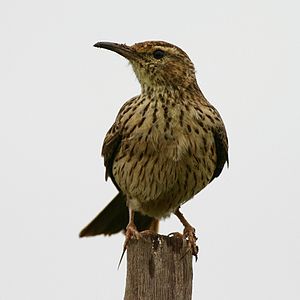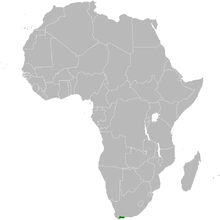Agulhas long-beaked lish
| Agulhas long-beaked lish | ||||||||||||
|---|---|---|---|---|---|---|---|---|---|---|---|---|

Agulhas Longbeak, De Hoop Nature Reserve , South Africa |
||||||||||||
| Systematics | ||||||||||||
|
||||||||||||
| Scientific name | ||||||||||||
| Certhilauda brevirostris | ||||||||||||
| Roberts , 1941 |
The Agulhas Langschnabel lark ( Certhilauda brevirostris ) is a large bird art from the family of larks. It is larger than a skylark , has a longer and more curved bill, and is a thrush-like shape. The distribution area of the Agulhas long-beaked lark is in southern Africa. No subspecies are distinguished. The Agulhas long-beaked lark has long been classified as a subspecies of the long-beaked lark. Due to its genetic data, however, it is now classified as an independent species.
The stock situation of the Agulhas long-beaked lark is classified as potentially endangered due to habitat loss. Its name is derived from Cape Agulhas .
features
The Agulhas long-beaked lobster reaches a body length of about 18 to 21 centimeters and weighs between 35 and 48 grams. The beak measures 2 to 2.2 centimeters measured from the head. There is no gender dimorphism. However, males are on average larger than females, are correspondingly heavier and have a slightly longer beak.
The Agulhas long-beaked lobster has a gray-brown to ocher-colored top of the body with darker dashes. The underside of the body is pale creamy white. The chest is dashed dark. On her face she has a whitish eye ring and an equally colored over-eye stripe.
The male's call is a two-syllable psiii-oooo .
Distribution area and habitat
The Agulhas long-beaked lark is only found in the extreme south of Africa. The distribution area is no larger than 15,000 square kilometers and extends from Cape Agulhas to the South African city of Knysna. The distribution area is thus in the Western Cape Province . The Agulhas long-beaked lobster is a resident bird in the entire distribution area .
In this region it inhabits plains of the Cape and the Breede Valley . Today this region is heavily used for agriculture. Wheat cultivation and livestock farming are typical, the original Fynbos and Karoo vegetation has largely disappeared. The original habitat of this species of lark is therefore only given to a small extent. It occurs on fallow land and freshly plowed fields. More intensively used agricultural land is avoided by it.
Way of life
The Agulhas long-beaked plate covers its food needs mainly with insects and to a lesser extent with seeds. She finds her food on the ground. Occasionally it digs with its beak or uses its feet to paw in the vegetation.
Like all larks, the Agulhas long-billed lark is a ground-breeder. The time of oviposition falls between September and October. The nestlings fledge between October and November.
literature
- Rudolf Pätzold : The larks of the world . Westarp Sciences, Magdeburg 1994, ISBN 3-89432-422-8 .
- Rudolf Pätzold: Compendium of Larks. All the larks on earth. Jan-Schimkat-Medienpublikation, Dresden 2003, ISBN 3-00-011219-7 .
- CG Sibley and BL Monroe (1990): Distribution and taxonomy of birds of the world . New Haven, USA: Yale University Press. ISBN 0-300-04969-2 , ISBN 978-0-300-04969-5
- CG Sibley and BL Monroe (1993): A supplement to Distribution and taxonomy of birds of the world . New Haven, USA: Yale University Press.
